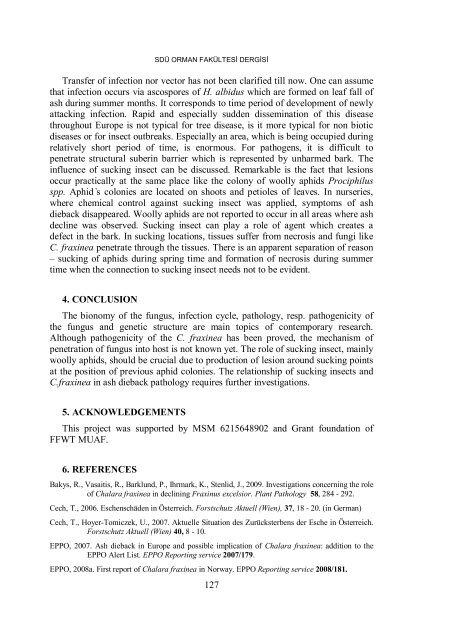sdu faculty of forestry journal special edition 2009 - Orman Fakültesi
sdu faculty of forestry journal special edition 2009 - Orman Fakültesi
sdu faculty of forestry journal special edition 2009 - Orman Fakültesi
Create successful ePaper yourself
Turn your PDF publications into a flip-book with our unique Google optimized e-Paper software.
SDÜ ORMAN FAKÜLTESİ DERGİSİ<br />
Transfer <strong>of</strong> infection nor vector has not been clarified till now. One can assume<br />
that infection occurs via ascospores <strong>of</strong> H. albidus which are formed on leaf fall <strong>of</strong><br />
ash during summer months. It corresponds to time period <strong>of</strong> development <strong>of</strong> newly<br />
attacking infection. Rapid and e<strong>special</strong>ly sudden dissemination <strong>of</strong> this disease<br />
throughout Europe is not typical for tree disease, is it more typical for non biotic<br />
diseases or for insect outbreaks. E<strong>special</strong>ly an area, which is being occupied during<br />
relatively short period <strong>of</strong> time, is enormous. For pathogens, it is difficult to<br />
penetrate structural suberin barrier which is represented by unharmed bark. The<br />
influence <strong>of</strong> sucking insect can be discussed. Remarkable is the fact that lesions<br />
occur practically at the same place like the colony <strong>of</strong> woolly aphids Prociphilus<br />
spp. Aphid`s colonies are located on shoots and petioles <strong>of</strong> leaves. In nurseries,<br />
where chemical control against sucking insect was applied, symptoms <strong>of</strong> ash<br />
dieback disappeared. Woolly aphids are not reported to occur in all areas where ash<br />
decline was observed. Sucking insect can play a role <strong>of</strong> agent which creates a<br />
defect in the bark. In sucking locations, tissues suffer from necrosis and fungi like<br />
C. fraxinea penetrate through the tissues. There is an apparent separation <strong>of</strong> reason<br />
– sucking <strong>of</strong> aphids during spring time and formation <strong>of</strong> necrosis during summer<br />
time when the connection to sucking insect needs not to be evident.<br />
4. CONCLUSION<br />
The bionomy <strong>of</strong> the fungus, infection cycle, pathology, resp. pathogenicity <strong>of</strong><br />
the fungus and genetic structure are main topics <strong>of</strong> contemporary research.<br />
Although pathogenicity <strong>of</strong> the C. fraxinea has been proved, the mechanism <strong>of</strong><br />
penetration <strong>of</strong> fungus into host is not known yet. The role <strong>of</strong> sucking insect, mainly<br />
woolly aphids, should be crucial due to production <strong>of</strong> lesion around sucking points<br />
at the position <strong>of</strong> previous aphid colonies. The relationship <strong>of</strong> sucking insects and<br />
C.fraxinea in ash dieback pathology requires further investigations.<br />
5. ACKNOWLEDGEMENTS<br />
This project was supported by MSM 6215648902 and Grant foundation <strong>of</strong><br />
FFWT MUAF.<br />
6. REFERENCES<br />
Bakys, R., Vasaitis, R., Barklund, P., Ihrmark, K., Stenlid, J., <strong>2009</strong>. Investigations concerning the role<br />
<strong>of</strong> Chalara fraxinea in declining Fraxinus excelsior. Plant Pathology 58, 284 - 292.<br />
Cech, T., 2006. Eschenschäden in Österreich. Forstschutz Aktuell (Wien), 37, 18 - 20. (in German)<br />
Cech, T., Hoyer-Tomiczek, U., 2007. Aktuelle Situation des Zurücksterbens der Esche in Österreich.<br />
Forstschutz Aktuell (Wien) 40, 8 - 10.<br />
EPPO, 2007. Ash dieback in Europe and possible implication <strong>of</strong> Chalara fraxinea: addition to the<br />
EPPO Alert List. EPPO Reporting service 2007/179.<br />
EPPO, 2008a. First report <strong>of</strong> Chalara fraxinea in Norway. EPPO Reporting service 2008/181.<br />
127








